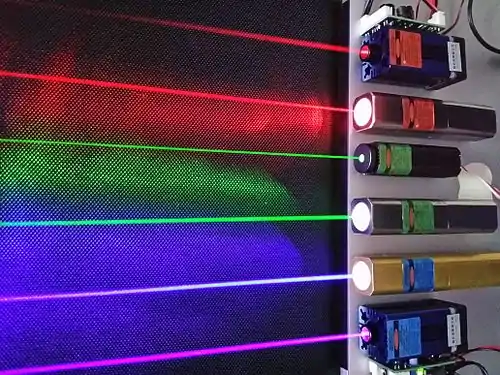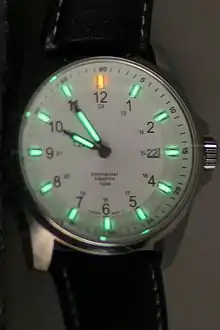This is a list of sources of light, the visible part of the electromagnetic spectrum. Light sources produce photons from another energy source, such as heat, chemical reactions, or conversion of mass or a different frequency of electromagnetic energy, and include light bulbs and stars like the Sun. Reflectors (such as the moon, cat's eyes, and mirrors) do not actually produce the light that comes from them.
Incandescence
Incandescence is the emission of light from a hot body as a result of its temperature.
- Nernst lamp – Early form of lamp using an incandescent ceramic rod
- Volcanic eruption – Overview of different types of volcanic eruptions
 Volcanic eruption
Volcanic eruption
Combustion
Lamps
- Argand lamp – Type of oil lamp (obsolete)
- Carbide lamp – Acetylene-burning lamps
- Coleman lantern – Series of pressure lamps
- Betty lamp – Oil or grease burning lamp originating from Europe (error)
- Butter lamp – Lamps traditionally burning clarified yak butter
- Flash-lamp – Electrically ignited photographic light source
- Gas lighting – Type of artificial light
- Gas mantle – Device for generating bright light when heated by a flame
- Kerosene lamp – Type of lighting device that uses kerosene as a fuel
- Lantern – Portable lighting devices
- Limelight – Type of stage lighting once used in theatres and music halls (obsolete)
- Oil lamp – Lamp used for lighting by burning oil
 Oil lamp
Oil lamp - Tilley lamp – Pressurized kerosene lamps made by the Tilley company in the UK
Other
- Argon flash – Single-use source of very short and extremely bright flash of light - shock wave
- Brazier – Container used to burn charcoal or other solid fuel
- Bunsen burner – Laboratory device used to make fire from fuel and oxidizer gases
- Candle – Wick embedded in solid flammable substance
.jpg.webp) Candle
Candle - Ember – A hot lump of slowly burning solid fuel, usually associated with a fire
- Explosive – Substance that can explode
- Fire – Rapid and hot oxidation of a material
 Fire
Fire - Fire whirl – Whirlwind induced by and often composed of fire
 Fire whirl
Fire whirl - Fireworks – Low explosive pyrotechnic devices for entertainment
 Fireworks
Fireworks - Flamethrower – Ranged incendiary device designed to project a controllable stream of fire
- Incandescent light bulb – Electric light bulb with a resistively heated wire filament
- Muzzle flash – Light created by gunfire
- Rubens tube – Physics apparatus for demonstrating acoustic standing waves in a tube
- Torch – Stick with a flaming end used as a source of light
Nuclear and high-energy particle
- Annihilation – Collision of a particle and its antiparticle
- Nuclear reaction – Transformation of a nuclide to another
- Nuclear fission – Nuclear reaction splitting an atom into multiple parts
- Nuclear fusion – Process of combining atomic nuclei
- Nuclear weapon – Explosive device that derives its destructive force from nuclear reactions
- Cherenkov radiation – EM from a charged particle in a medium
- Synchrotron radiation – Electromagnetic radiation emitted by charged particles accelerated perpendicular to their velocity
- Free-electron laser – Laser using electron beam in vacuum as gain medium
- Bremsstrahlung – Electromagnetic radiation due to deceleration of charged particles
Celestial and atmospheric


- Astronomical objects
- Sun (sunlight, solar radiation)
- Stellar corona – Outermost layer of a star's atmosphere
- Photosphere – Star's outer shell from which light is radiated
- Star (Starlight)
- Deep-sky object – Any astronomical object that is not an individual star
- Quasar – Active galactic nucleus containing a supermassive black hole
- Accretion disk – Structure formed by diffuse material in orbital motion around a massive central body
- Blazar – Very compact quasi-stellar radio source
- Magnetar – Type of neutron star with a strong magnetic field
- Pulsar – Highly magnetized, rapidly rotating neutron star
- Sun (sunlight, solar radiation)
- Atmospheric entry – Passage of an object through the gases of an atmosphere from outer space
- Meteor
 Meteor
Meteor- Meteor shower – Celestial event caused by streams of meteoroids entering Earth's atmosphere
- Bolide – Extremely bright meteor
- Earth-grazing fireball – Meteoroid that enters Earth's atmosphere and leaves again
- Meteor
- Lightning (Plasma)
- Sprite (lightning) – Electrical discharges above thunderstorm clouds
- Ball lightning – Atmospheric electrical phenomenon
- Upper-atmospheric lightning – Rare transient luminous events that occurs over tops of thunder storms
- Dry lightning – Thunderstorm where little to no precipitation reaches the ground
- Aurora – Natural luminous atmospheric effect observed chiefly at high latitudes
Luminescence
Luminescence is emission of light by a substance not resulting from heat.
Bioluminescence
Bioluminescence is light resulting from biochemical reaction by a living organism.
- Aequorea victoria – Species of hydrozoan
- Antarctic krill – Species of krill
- Biophoton – Photon from a biological source
- Cavitation bubbles made by mantis shrimps
- Firefly – Family of beetles
- Foxfire – Fungal bioluminescence
- Glowworm – Bioluminescent insect larve
- Luciferase – Enzyme family
- Panellus stipticus – Species of fungus in the family Mycenaceae found in Asia, Australia, Europe, and North America
 Bioluminescent panellus stipticus
Bioluminescent panellus stipticus - Parchment worm – Genus of annelid worms
- Piddock – Family of bivalves
- Anglerfish – Bony fish of the teleost order Lophiiformes
Cathodoluminescence
Cathodoluminescence is light resulting from a luminescent material being struck by electrons.
Chemiluminescence

Chemiluminescence is light resulting from a chemical reaction.
Cryoluminescence
Cryoluminescence is the emission of light when an object is cooled.
Crystalloluminescence
Crystalloluminescence is light produced during crystallization.
Electric discharge (electrical energy)
-
- Lightning – Weather phenomenon involving electrostatic discharge
- Electric spark – Abrupt electrical discharge through an ionised channel
-
- Electrodeless lamp – Gas-discharge lamp using electric and magnetic fields to transfer energy to the gas inside
- Excimer lamp – Ultraviolet source based on spontaneous emission of excimer molecules.
- Fluorescent lamp – Lamp using fluorescence to produce light
- Compact fluorescent lamp – Fluorescent lamps with folded tubes, often with built-in ballast
- Tanning lamp – Device which produces ultraviolet light used for indoor tanning
- Blacklight – Light fixture that emits long-wave ultraviolet light and very little visible light
- Geissler tube – Early gas-discharge lamp
- Moore tube – American scientist (1869-1936) (Obsolete)
- Ruhmkorff lamp – Artificial light sources powered by ionized gas electric discharge (Obsolete)
- High-intensity discharge lamp – Type of electric lamp/bulb
 High-intensity discharge lamp
High-intensity discharge lamp- Carbon arc lamp – Lamp that produces light by an electric arc
- Ceramic metal-halide lamp
- Hydrargyrum medium-arc iodide lamp – used for stage lighting
- Mercury-vapor lamp – Light source using an electric arc through mercury vapor
- Metal-halide lamp – Type of lamp
- Sodium-vapor lamp – Type of electric gas-discharge lamp
- Sulfur lamp – Lighting system
- Xenon arc lamp – Gas discharge lamp that produces intense white light
- Hollow-cathode lamp – spectral line source used in physics and chemistry
- Induction lighting – Gas-discharge lamp using electric and magnetic fields to transfer energy to the gas inside
- Sulfur lamp – Lighting system
 Sulfur lamps
Sulfur lamps
- Sulfur lamp – Lighting system
- Neon and argon lamps – Light source based on gas discharge
- Dekatron – Early and obsolete type of computer memory
 Dekatron
Dekatron - Nixie tube – Electronic numeric display device
- Dekatron – Early and obsolete type of computer memory
- Plasma lamp – Type of electrodeless gas-discharge lamp
- Xenon flash lamp – Incoherent light source
Electrochemiluminescence
Electrochemiluminescence is light resulting from an electrochemical reaction.
Electroluminescence
Electroluminescence is light resulting from an electric current being passed through a substance.

- Light-emitting diode – Semiconductor and solid-state light source
- Organic light-emitting diode – Diode that emits light from an organic compound
- Polymer light-emitting diode – Diode that emits light from an organic compound
- AMOLED, Active matrix OLED - typical OLED addressing scheme for color OLED displays. (Display content) Has to be periodically refreshed to maintain picture, as opposed to for example Electronic paper – Display technology for use in mobile devices and televisions
- Light-emitting electrochemical cell – solid-state device that generates light from an electric current
- Electroluminescent wire – Capacitive light source in the form of a wire
- Field-induced polymer electroluminescent
- Laser – Device which emits light via optical amplification
 Lasers
Lasers- Chemical laser – Laser that obtains energy from chemical reactions
- Dye laser – Equipment using an organic dye to emit coherent light
- Free-electron laser – Laser using electron beam in vacuum as gain medium
- Gas dynamic laser – Laser based on differences in relaxation velocities of molecular vibrational states
- Gas laser – Laser in which electricity is discharged through gas
- Ion laser – Type of gas laser
- Laser diode – Semiconductor laser
- Laser excited phosphor – Devices and processes that produce light Long distance beam light
- Metal-vapor laser
- Nonlinear optics – Branch of physics
- Quantum well laser – Laser diode in which the active region is so narrow that quantum confinement occurs
- Quantum dot laser – Semiconductor laser that uses quantum dots as the active laser medium
- Ruby laser – Solid-state laser
- Solid-state laser – Laser which uses a solid gain medium
Mechanoluminescence
Mechanoluminescence is light resulting from a mechanical action on a solid.
- Triboluminescence, light generated when bonds in a material are broken when that material is scratched, crushed, or rubbed
- Fractoluminescence, light generated when bonds in certain crystals are broken by fractures
- Piezoluminescence, light produced by the action of pressure on certain solids
- Sonoluminescence, light resulting from imploding bubbles in a liquid when excited by sound
Photoluminescence
Photoluminescence is light resulting from absorption of photons.
- Fluorescence, the emission of light by a substance that has absorbed light or other electromagnetic radiation
- Phosphorescence, the delayed re-emission of light by substance that has absorbed it
Radioluminescence

Radioluminescence is light resulting from bombardment by ionizing radiation.
Thermoluminescence
Thermoluminescence is light from the re-emission of absorbed energy when a substance is heated.
See also
References
External links
- A CD spectrometer Color spectrographs of common light sources

.jpg.webp)
